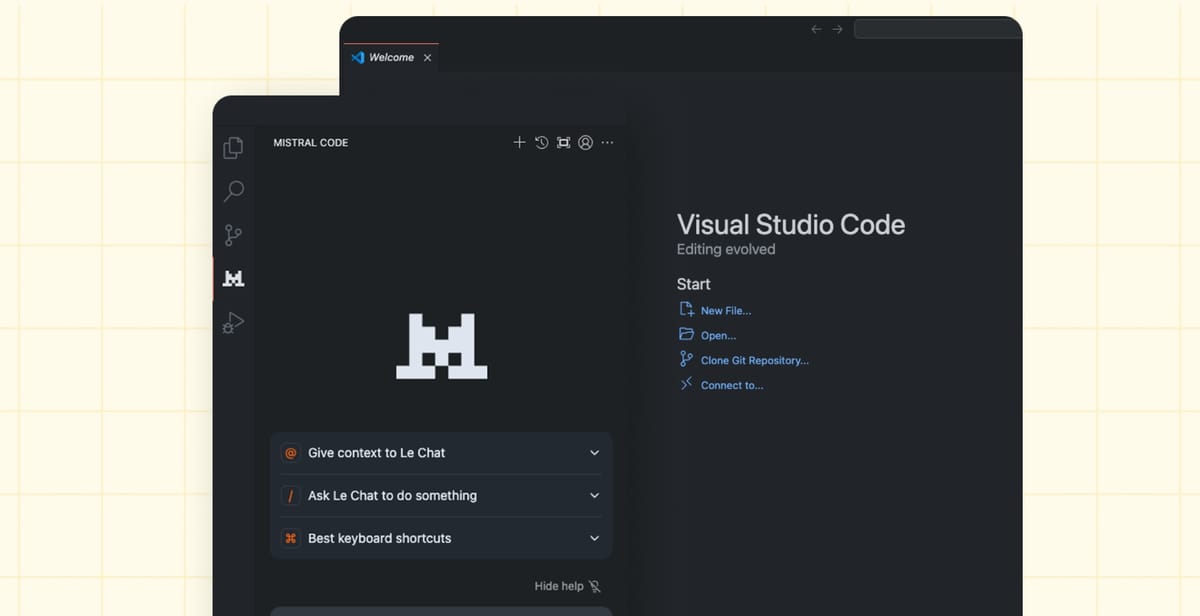
Mistral AI is betting that enterprise developers are fed up with hitting compliance walls every time they try to use AI coding tools. The French startup's new Mistral Code assistant tackles the specific regulatory and security roadblocks that have kept other coding assistants stuck in proof-of-concept purgatory at many large companies.
Key Points:
- Product forks Continue but adds RBAC, audit logging and model fine-tuning
- Codestral, Devstral, Codestral Embed and Mistral Medium models under one roof
- Private beta now available for JetBrains and VS Code; cloud, reserved or air-gapped GPU deployment
The company surveyed VPs of engineering and CISOs to understand why promising pilots weren't scaling, and the answers were predictable: limited repo connectivity, minimal customization, shallow task coverage, and fragmented vendor relationships.
"Unlike typical SaaS copilots, all parts of the stack—from models to code—are delivered by one provider subject to a single set of SLAs, and every line of code resides inside the customer's enterprise boundary," the company explained in its announcement.

That's enterprise-speak for "your code never leaves your servers," which matters more than you might think. Security and compliance concerns consistently top the list of reasons why enterprises hesitate to invest in AI, with regulatory uncertainty keeping compliance teams from approving new tools.
Mistral Code builds on Continue, an open-source project that already had the core IDE integrations figured out. Rather than reinventing the wheel, Mistral forked the project and layered on enterprise features like fine-grained access controls, audit logging, and usage analytics. It's a smart move that lets them focus on the harder problem of enterprise deployment rather than building yet another autocomplete engine.
The product runs on four of Mistral's models: Codestral for code completion, Codestral Embed for search, Devstral for agentic coding tasks, and Mistral Medium for chat assistance. More importantly for enterprises, customers can fine-tune these models on their private repositories—something that's impossible with closed APIs from other providers.
Early customers suggest this approach is working. Abanca, a Spanish bank, deployed Mistral Code in a hybrid setup that lets developers prototype in the cloud while keeping core banking code on-premises. SNCF, France's national railway, is using the serverless version for 4,000 developers. Capgemini plans to deploy it on-premises for 1,500+ developers working on regulated client projects.
The European angle matters here. While American AI companies navigate a patchwork of emerging regulations, Mistral's European heritage provides regulatory advantages under GDPR and the EU AI Act, which impose strict requirements on AI systems processing personal data.
But Mistral faces real challenges. The AI coding market is consolidating rapidly, with acquisitions and rumored multi-billion dollar deals reshaping the landscape. GitHub Copilot has massive distribution through Microsoft's ecosystem, and newer players like Cursor have captured developer mindshare with innovative features. And then there is Codex, OpenAI's impressive cloud-based software engineering agent.
Still, there's clearly demand for what Mistral is building. By 2027, 70% of professional developers will be using AI-powered coding tools, and Google already generates more than a quarter of new code with AI. The race isn't just about who builds the best autocomplete—it's about who can thread the needle between developer productivity and enterprise paranoia.
Mistral Code's private beta launches today for JetBrains and VS Code, with broader availability planned as they collect customer feedback. Whether it can carve out meaningful market share depends on how quickly the compliance-conscious enterprise market grows. For now, Mistral has a clear thesis: developers want AI assistance, enterprises want control, and there's real money in being the company that delivers both.

